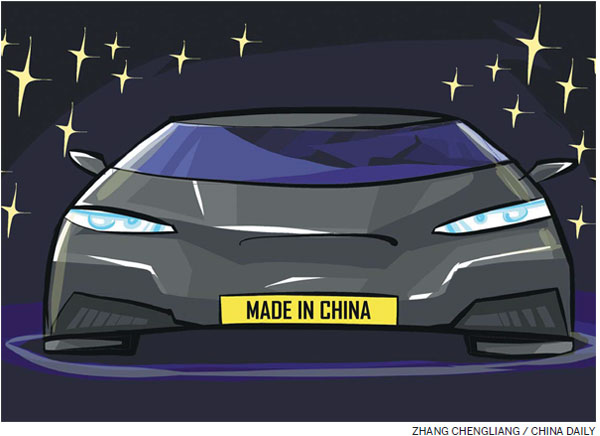Chinese brands in the driving seat
Updated: 2015-05-08 07:35
By Mike Bastin(China Daily Europe)
|
|||||||||||
Shanghai show was evidence of a new-found confidence in domestic automakers
This year's Shanghai auto show, the most eagerly awaited industry event in China, if not the world, may have captured global headlines for the absence of the usual scantily clad "booth babes", but it was most notable for the step-wise increase in competitiveness of the Chinese car brands on display.
Chinese car brands used to be stuck at the lower end of their domestic market, while foreign competitors dominated the more profitable top end. This year's show suggested that a major change is taking place and that the Chinese automotive industry is fighting back with some success.

No longer do we see cheap knockoffs; instead at this year's show Chinese automakers proudly presented upmarket, high-tech models.
Dongfeng Motor Corp, whos headquarters are in Wuhan, Hubei province, unveiled an extremely impressive mass-production sedan. Also making its debut was the Guangzhou Auto Trumpchi GA8, which many argue ranks as one of the most beautiful Chinese sedans ever built. Both models were little more than a concept less than a year ago. At the show, too, Chinese-owned Volvo played its flagship GC9 sedan.
Another distinguishing feature of the Shanghai show is many environmentally friendly vehicles on display. A record 103 new-energy cars were present, as domestic and foreign automotive sectors battle for the increasingly green-oriented Chinese consumer.
Of these 103 cars, almost half were Chinese brands, in part influenced by the central government's policies toward sustainable growth and a cleaner, greener China.
Among the 51 domestic new-energy models, often a combination of hybrids and plug-ins, it was perhaps BYD with its Song Yuan plug-in hybrid and Hawtai Motor's Lusheng E70EV that were most representative of the increasingly competitive Chinese auto sector.
The increased competitiveness is also due to changes in attitudes toward foreign car brands among Chinese consumers. The once automatic adoration of major foreign brands such as Audi and BMW is waning, as Chinese consumers become far more independent and rational in their decision-making.
It is not only foreign automakers that need to understand this inevitable and unstoppable trend and rethink their entire branding approach to Chinese consumers. A recent 20-percent price reduction by French luxury cosmetics brand Chanel also provides firm evidence that Chinese consumers are switching from well-known foreign brands. Chanel's image and associations can no longer command a premium price, as Chinese consumers continue to redefine how they construct "prestige" and "exclusivity".

The need for information in order to make informed consumption choices is also evident in the numbers of Chinese attending the Shanghai auto show. The number reached 800,00 two years ago, but this year's attendance could surpass the one million mark.
The theme for this year's show, Innovation for Upgrading, probably contributed to its popularity. But it is also a reflection of the changing brand-building business models adopted by many Chinese automakers.
Many auto industry commentators agree that Chinese brands now rightly justify higher prices due to far more sophisticated design and manufacturing. Crucially, this narrowing of the gap in quality between the long-established foreign brands is most appreciated and accepted by Chinese consumers.
The more-discerning Chinese consumer could enable Chinese auto brands to narrow and even close this quality gap with foreign competitors within a couple of years.
This could force many of the most famous international car brands to forge long-term co-branding partnerships with China's leading automotive sector players such as Great Wall Motor, Geely and BYD.
The European and United States automotive industry must acknowledge and accept this quality-driven and premium brand orientation that now permeates plenty of China's leading automakers.
Geely is perhaps most representative of this seismic shift. Until recently, the company has been associated with budget cars, but none of the models on display at the Shanghai show this year could be placed anywhere near this category.
Despite the surge in sophistication, it remains the case that foreign brands retain a substantial lead in domestic market share.
According to the China Association of Automobile Manufacturers, Chinese brands' combined market share of the domestic sedan market for last year reached only 22.4 percent.
However, foreign automakers should take cold comfort from this statistic, which could serve to mask major changes in both Chinese car consumption decision-making and Chinese automaker brand-building.
Brand image and emotional brand associations are perhaps the reasons why foreign car brands retain such a substantial market share advantage across the Chinese mainland.
BMW and Audi, for example, still occupy an extremely attractive position in the network of associations inside the typical Chinese car consumer's mind. But even this is now at stake. In much the same way that Chanel's heritage and plethora of associations is becoming less influential in the minds of its Chinese target markets, BMW and Audi's German brand background will not lead automatically to market success as it once did.
Chinese automakers are not only rapidly climbing the value chain with high-quality design and manufacturing, but are also more proudly presenting themselves as part of brand China. Chinese companies generally, not just the automotive sector, have been empowered by the Chinese dream.
Chinese consumers have been waiting a long time for the rise in quality of Chinese products, as well as the presentation of Chinese brands with Chinese associations. The time has come.
BMW can no longer present itself to the Chinese public as a German brand or even a German global brand. Instead, a subtle blend of foreign and, most importantly, Chinese characteristics will be demanded more by an increasingly savvy Chinese public.
As this new-found brand-building confidence sweeps across the Chinese automotive sector, expect to see more sophisticated representations of Chinese brand associations employed by leading automakers.
The European and US players quickest to understand these irreversible changes and form long-term alliances with suitable Chinese counterparts will turn this apparent market threat into a massive opportunity; a win-win for both foreign and Chinese co-brand partners.
The innovative clothing brand Shanghai Tang was the first Chinese company to break the poor image of "made in China" and employ Chinese-only brand associations. In only a few years it has arguably established itself as the first luxury Chinese brand. Expect the Chinese auto industry and many other sectors to follow suit.
This year's Shanghai auto show is perhaps the Chinese car industry's Shanghai Tang moment.
The author is a visiting professor at the University of International Business and Economics in Beijing and a senior lecturer at Southampton University. The views do not necessarily reflect those of China Daily.
(China Daily European Weekly 05/08/2015 page11)
Today's Top News
China-UK relations likely unaffected by election
China 'willing' to seek EU investment treaty
Record number of Chinese seek poll success
Russia's Putin, Germany's Merkel to discuss Ukraine on May 10
China pledges continued help as Nepal rebuilds
Rolling stock company forges ahead in Russia
Denmark receives 3 bomb threats in one day: media
Bilateral efforts 'inject fresh impetus'
Hot Topics
Lunar probe , China growth forecasts, Emission rules get tougher, China seen through 'colored lens', International board,
Editor's Picks

|

|

|

|

|

|






